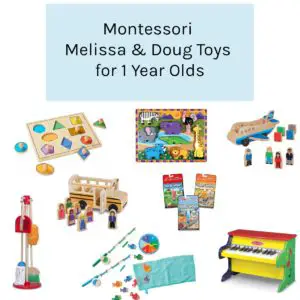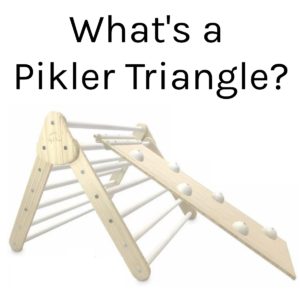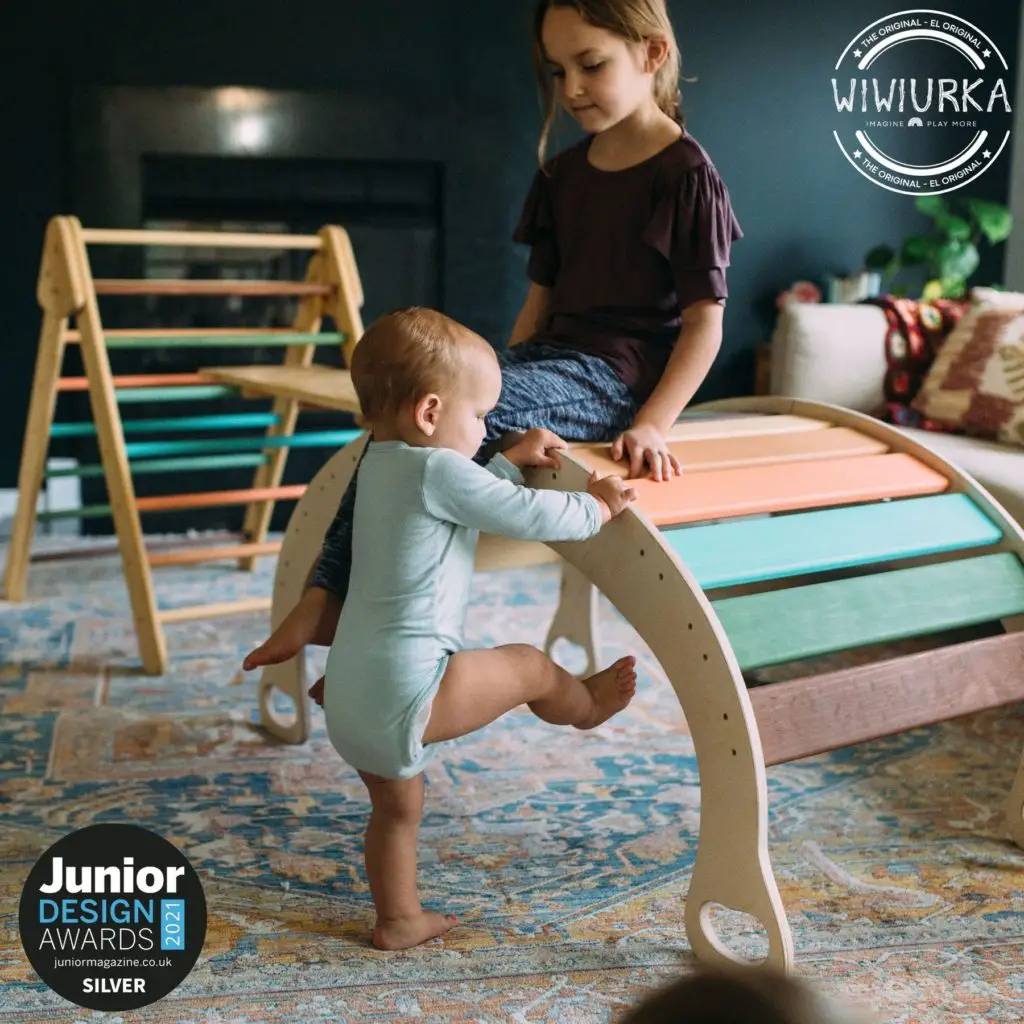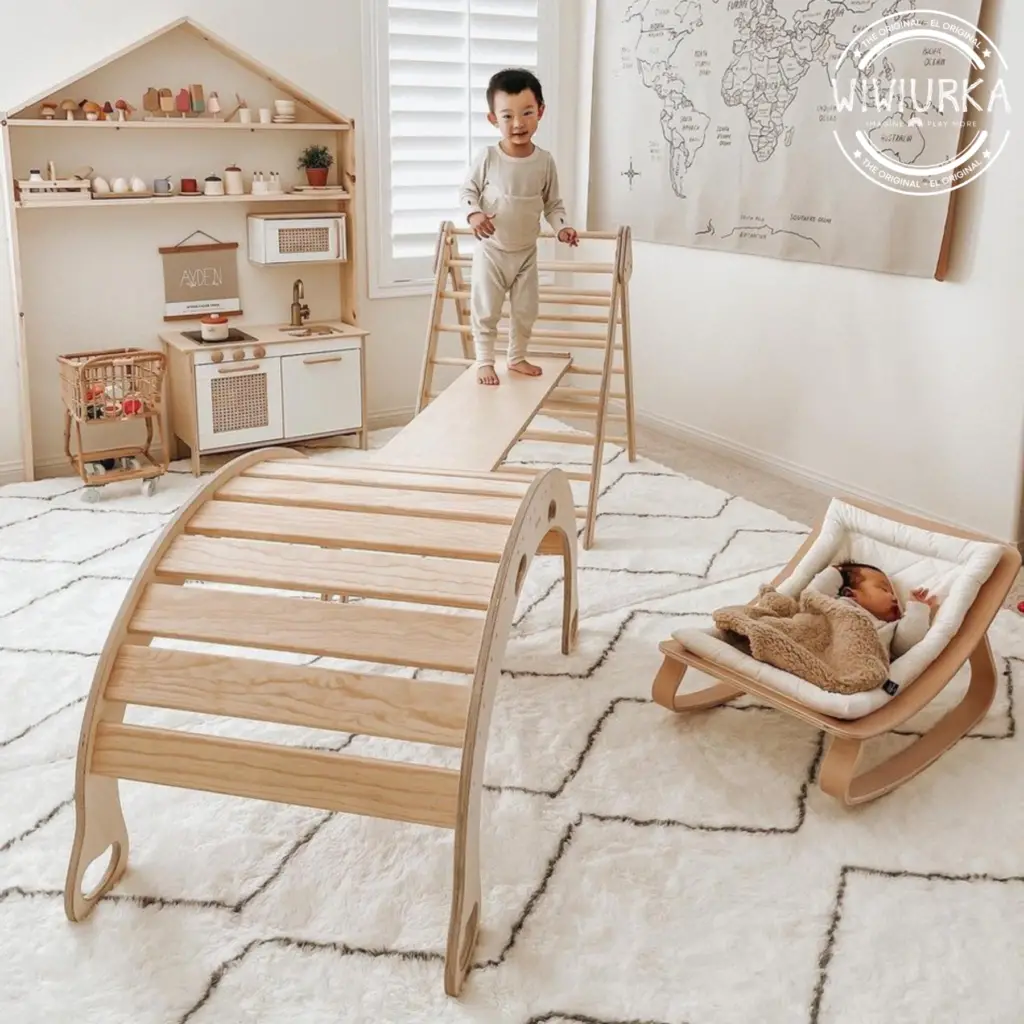

Note: This post may contain affiliate links. What does this mean?
A Pikler triangle is a climbing structure for children. And it’s not “Pickler” or “Picklar” which are common misspellings. The name comes from its creator, Dr. Emmi Pikler, a Hungarian pediatrician.
Dr. Pikler developed a child-rearing approach based on a kind and respectful relationship between an adult and infant, through tender care moments, a naturally paced motor development, free movement and uninterrupted play. Dr. Pikler believed in the child’s inherent ability to guide his or her own motor development.
This is where the Pikler’s triangle comes into play. The Pikler triangle is a climbing structure that children learn to navigate on at their own pace. The Pikler triangle allows children to explore their body, learn their own boundaries and respond to their climbing needs. It also helps develop gross motor skills, physical strength and agility, encouraging free movement and free play.
It can be introduced at 6 months old and generally can be expected to be used up until age 5.
Around 6 months of age, babies can use the rungs of the Pikler triangle to pull up and stand. As they develop, children begin exploring the structure by climbing part way up then back down (around 1-2 years of age). Older children (around 4-5 years of age) typically “master” the Pikler triangle and are able to climb all the way to the top and climb over and down the other side.
Though the Pikler triangle is optimal for 6 month olds to 5 year olds, it can still be useful for those outside this age range. For instance, newborns could lay under the Pikler triangle with toys hanging from the rungs, similar to a play gym. Older children will likely find creative uses for the Pikler triangle, such as forts, puppet shows, or other open-ended play.
Although the Pikler triangle is often found in Montessori-inspired classrooms and homes, the Pikler Triangle in and of itself, is not Montessori.
However, the Pikler Triangle fits in perfectly to the Montessori philosophy of natural gross motor development. Part of natural gross motor development means allowing children to develop their gross motor skills at their own pace.
Related: Nugget Couch Review!
The Pikler triangle has limitless indoor play uses when left up to a child’s imagination. Because of the many ways in which a kid can play with it, many people even relate it to the famous Nugget couch! Like the Nugget, it can be used to climb on (of course), used as a fort or a tent when a blanket or a sheet is draped over it or anything else your child can imagine. Many people even go as far as purchasing BOTH a Nugget and a Pikler triangle and use them together!
There are many accessories that can be purchased to accompany your Pikler triangle that can expand its use and enhance play. A couple of these include a ladder/slide and a rockwall/slide. The ladder consists of a flat board that attaches to any rung of the triangle. One side of the board has a flat surface and the other has graspable rungs your child can use to climb up the board. The rockwall is the same basic smooth board on one side but with a rockwall on the other side. Of course they are both reversible so the flat side or rockwall/ladder side can both be used. One or both of these accessories can entertain children for hours.
There are various modern-day renditions of the Pikler triangle (i.e. “Pikler inspired”).
Each one is slightly different. There are various sizes as well as different accessories available.
One popular brand of “Pikler inspired” triangles in the United States is made by Lily & River.
Lily & River’s version of the Pikler triangle is called The Little Climber. Lily & River makes their climber in the United States and with safe, non-toxic materials.
You can also get various accessories with your Lily & River climber – like a 2-in-1 slide and rock wall (one side’s a rock wall and the other side is a slide!), or a 2-in-one slide and ladder.
The price tag of this Pikler triangle is steep, but everyone who has one says it’s well worth it!
Another popular brand of “Pikler inspired” triangles in the United States is made by Sprout Kids.
The Sprout Kids version of the Pikler triangle is called the Wooden Climbing Triangle. Sprout Kids makes their climber in the United States and with safe, non-toxic materials.
You can also get an accessory added on to your climber. One side is a ladder and one side is a slide!
Another very popular brand of “Pikler-inspired” triangles we recommend is Wiwiurka. They are a socially responsible company that makes their climber with safe, non-toxic materials.
The Wiwiurka version of the Pikler triangle is called the Foldable Climbing Triangle. Wiwiurka’s Pikler triangles are unqiue in that they offer multiple color options, as well as 3 different sizes.
Wiwiurka is also well-known for their Rocker Balance Boards, which are often used in conjunction with their Pikler triangle and Reversible Ramp (one side is a slide, one side is a ladder), as shown below. Wiwiurka also has multiple other accessories for the Pikler.


Check out our full review of the Wiwiurka Pikler triangle:
If you’re trying to decide between these 3 brands of Pikler triangles, check out these articles:
If you found this helpful, please share and check out our other related articles!